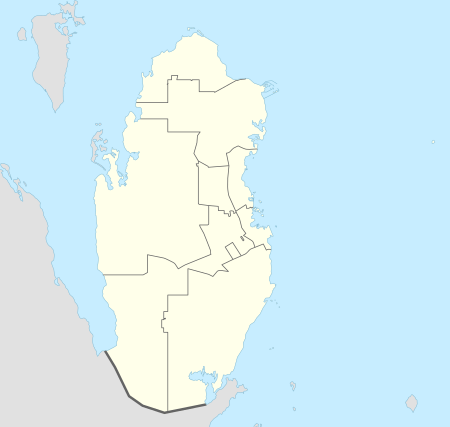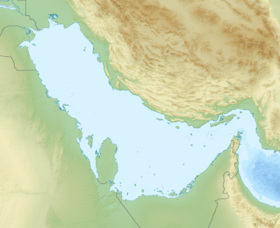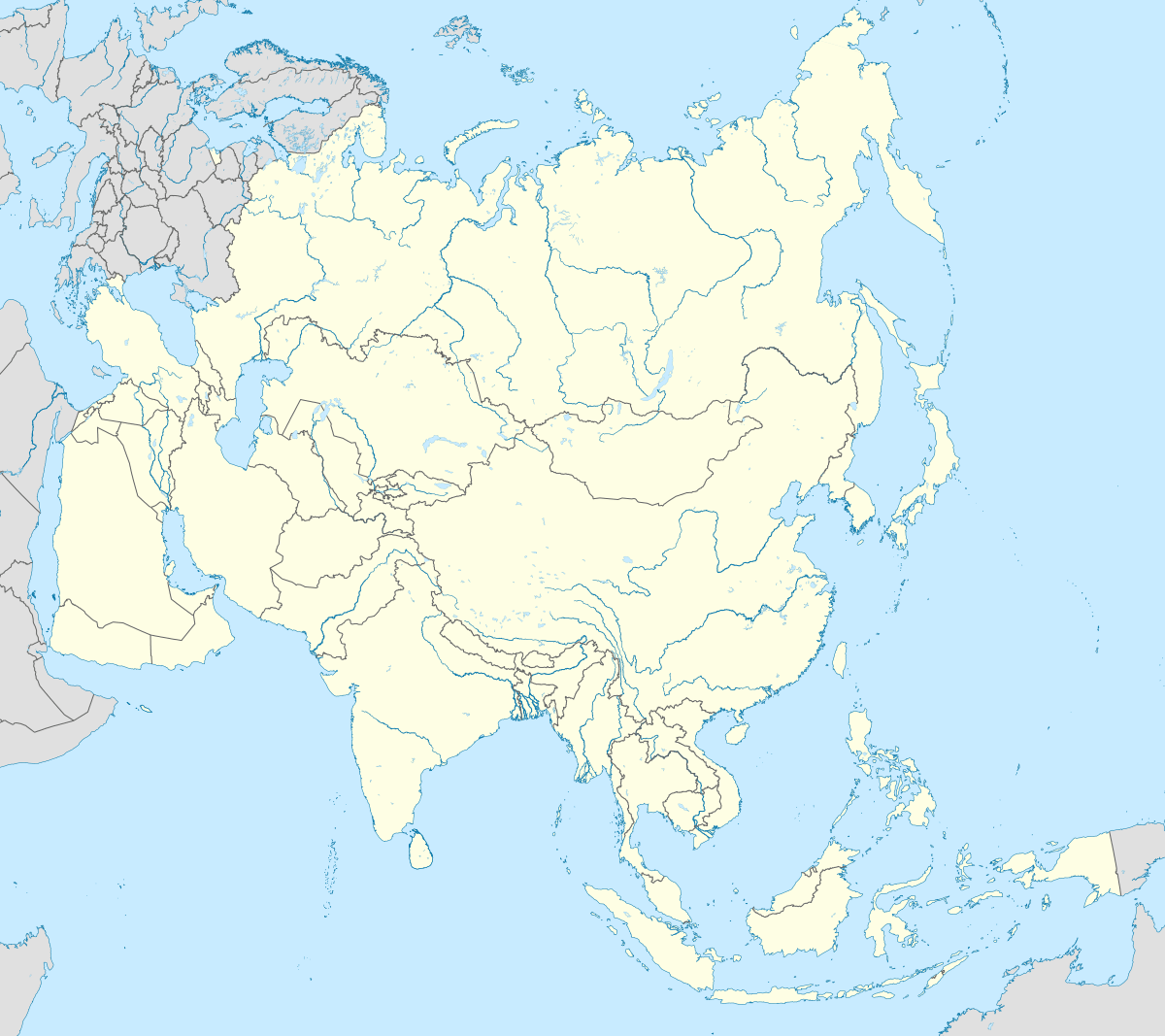Doha
Doha (Arabic: الدوحة, ad-Dawḥa or ad-Dōḥa, pronounced [adˈdawħa]) is the capital and most populous city of the State of Qatar. It has a population of 956,460 (2015).[1] The city is located on the coast of the Persian Gulf in the east of the country, North of Al Wakrah and South of Al Khor. It is Qatar's fastest growing city, with over 80% of the nation's population living in Doha or its surrounding suburbs,[2] and it is political and economic center of the country.
Doha الدوحة | |
|---|---|
Capital city | |
 Top to Bottom, Left to Right: Doha skyline in the morning, modern buildings in West Bay district, Amiri Diwan which serves as the office of the Amir of Qatar, Sheraton hotel, Souq Waqif, Sword Arch on Hamad Street | |
| Coordinates: 25°17′12″N 51°32′0″E | |
| Country | |
| Municipality | Ad-Dawhah |
| Established | 1825 |
| Area | |
| • City proper | 132 km2 (51 sq mi) |
| Population (2018) | |
| • City proper | 2,382,000 |
| • Density | 18,000/km2 (47,000/sq mi) |
| Time zone | UTC+3 (AST) |
Doha was founded in the 1820s as an offshoot of Al Bidda. It was officially declared as the country's capital in 1971, when Qatar gained independence from being a British Protectorate.[3] As the commercial capital of Qatar and one of the emergent financial centers in the Middle East, Doha is considered a beta-level global city by the Globalization and World Cities Research Network. Doha accommodates Education City, an area devoted to research and education; Hamad Medical City, an Hamad Medical Corporation administrative area of medical care which includes Hamad General Hospital, Heart Hospital, Women's Wellness and Research Center and Qatar Rehabilitation Institute as well as a number of specialty clinics and support infrastructure. Finally, it also includes Doha Sports City, or Aspire Zone, an international sports destination that includes Khalifa International Stadium, a FIFA WorldCup 2022 stadium, as well as Hamad Aquatic Center, and the Aspire Dome.
The city was host to the first ministerial-level meeting of the Doha Development Round of World Trade Organization negotiations. It was also selected as host city of a number of sporting events, including the 2006 Asian Games, the 2011 Pan Arab Games and most of the games at the 2011 AFC Asian Cup. In December 2011, the World Petroleum Council held the 20th World Petroleum Conference in Doha.[4] Additionally, the city hosted the 2012 UNFCCC Climate Negotiations and is set to host the 2022 FIFA World Cup.[5] The city has also hosted the 140th Inter-Parliamentary Union Assembly in April 2019.
Etymology
According to the Ministry of Municipality and Environment, the name "Doha" originated from the Arabic term dohat, meaning "roundness"—a reference to the rounded bays surrounding the area's coastline.[6]
History
Establishment of Al Bidda
The city of Doha was formed seceding from another local settlement known as Al Bidda. The earliest documented mention of Al Bidda was made in 1681, by the Carmelite Convent, in an account which chronicles several settlements in Qatar. In the record, the ruler and a fort in the confines of Al Bidda are alluded to.[7][8] Carsten Niebuhr, a German explorer who visited the Arabian Peninsula, created one of the first maps to depict the settlement in 1765 in which he labelled it as 'Guttur'.[7][9]
David Seaton, a British political resident in Muscat, wrote the first English record of Al Bidda in 1801. He refers to the town as 'Bedih' and describes the geography and defensive structures in the area.[10] He stated that the town had recently been settled by the Sudan tribe (singular Al-Suwaidi), whom he considered to be pirates. Seaton attempted to bombard the town with his warship, but returned to Muscat upon finding that the waters were too shallow to position his warship within striking distance.[11][12]
In 1820, British surveyor R. H. Colebrook, who visited Al Bidda, remarked on the recent depopulation of the town. He wrote:[11][13]
Guttur – Or Ul Budee [Al‐Bidda], once a considerable town, is protected by two square Ghurries [forts] near the sea shore; but containing no fresh water they are incapable of defence except against sudden incursions of Bedouins, another Ghurry is situated two miles inland and has fresh water with it. This could contain two hundred men. There are remaining at Ul Budee about 250 men, but the original inhabitants, who may be expected to return from Bahrein, will augment them to 900 or 1,000 men, and if the Doasir tribe, who frequent the place as divers, again settle in it, from 600 to 800 men.
The same year, an agreement known as the General Maritime Treaty was signed between the East India Company and the sheikhs of several Persian Gulf settlements (some of which were later known as the Trucial Coast). It acknowledged British authority in the Persian Gulf and sought to end piracy and the slave trade. Bahrain became a party to the treaty, and it was assumed that Qatar, perceived as a dependency of Bahrain by the British, was also a party to it.[14] Qatar, however, was not asked to fly the prescribed Trucial flag.[15] As punishment for alleged piracy committed by the inhabitants of Al Bidda and breach of treaty, an East India Company vessel bombarded the town in 1821. They razed the town, forcing between 300 and 400 natives to flee and temporarily take shelter on the islands between the Qatar and the Trucial Coast.[16]
Formation of Doha
Doha was founded in the vicinity of Al Bidda sometime during the 1820s.[17] In January 1823, political resident John MacLeod visited Al Bidda to meet with the ruler and initial founder of Doha, Buhur bin Jubrun, who was also the chief of the Al-Buainain tribe.[17][18] MacLeod noted that Al Bidda was the only substantial trading port in the peninsula during this time. Following the founding of Doha, written records often conflated Al Bidda and Doha due to the extremely close proximity of the two settlements.[17] Later that year, Lt. Guy and Lt. Brucks mapped and wrote a description of the two settlements. Despite being mapped as two separate entities, they were referred to under the collective name of Al Bidda in the written description.[19][20]
In 1828, Mohammed bin Khamis, a prominent member of the Al-Buainain tribe and successor of Buhur bin Jubrun as chief of Al Bidda, was embroiled in controversy. He had murdered a native of Bahrain, prompting the Al Khalifa sheikh to imprison him. In response, the Al-Buainain tribe revolted, provoking the Al Khalifa to destroy the tribe's fort and evict them to Fuwayrit and Ar Ru'ays. This incident allowed the Al Khalifa additional jurisdiction over the town.[21][22] With essentially no effective ruler, Al Bidda and Doha became a sanctuary for pirates and outlaws.[23]
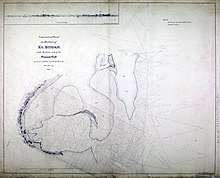
In November 1839, an outlaw from Abu Dhabi named Ghuleta took refuge in Al Bidda, evoking a harsh response from the British. A. H. Nott, a British naval commander, demanded that Salemin bin Nasir Al-Suwaidi, chief of the Sudan tribe (Suwaidi) in Al Bidda, take Ghuleta into custody and warned him of consequences in the case of non-compliance. Al-Suwaidi obliged the British request in February 1840 and also arrested the pirate Jasim bin Jabir and his associates. Despite the compliance, the British demanded a fine of 300 German krones in compensation for the damages incurred by pirates off the coast of Al Bidda; namely for the piracies committed by bin Jabir. In February 1841, British naval squadrons arrived in Al Bidda and ordered Al-Suwaidi to meet the British demand, threatening consequences if he declined. Al-Suwaidi ultimately declined on the basis that he was uninvolved in bin Jabir's actions. On 26 February, the British fired on Al Bidda, striking a fort and several houses. Al-Suwaidi then paid the fine in full following threats of further action by the British.[23][24]
Isa bin Tarif, a powerful tribal chief from the Al Bin Ali tribe, moved to Doha in May 1843. He subsequently evicted the ruling Sudan tribe and installed the Al-Maadeed and Al-Kuwari tribes in positions of power.[25] Bin Tarif had been loyal to the Al Khalifa, however, shortly after the swearing in of a new ruler in Bahrain, bin Tarif grew increasingly suspicious of the ruling Al Khalifa and switched his allegiance to the deposed ruler of Bahrain, Abdullah bin Khalifa, whom he had previously assisted in deposing of. Bin Tarif died in the Battle of Fuwayrit against the ruling family of Bahrain in 1847.[25]
Arrival of the House of Al Thani
The Al Thani family migrated to Doha from Fuwayrit shortly after Bin Tarif's death in 1847 under the leadership of Mohammed bin Thani.[26][27] In the proceeding years, the Al Thani family assumed control of the town. At various times, they swapped allegiances between the two prevailing powers in the area: the Al Khalifa of Bahrain and the Bin Saudis.[26]
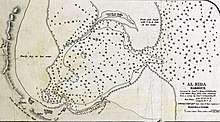
In 1867, many ships and troops were sent from Bahrain to assault the towns Al Wakrah and Doha over a series of disputes. Abu Dhabi joined on Bahrain's behalf due to the perception that Al Wakrah served as a refuge for fugitives from Oman. Later that year, the combined forces sacked the two Qatari towns with around 2,700 men in what would come to be known as the Qatari–Bahraini War.[28][29] A British record later stated "that the towns of Doha and Wakrah were, at the end of 1867 temporarily blotted out of existence, the houses being dismantled and the inhabitants deported".[30]
The joint Bahraini-Abu Dhabi incursion and subsequent Qatari counterattack prompted the British political agent, Colonel Lewis Pelly, to impose a settlement in 1868. Pelly's mission to Bahrain and Qatar and the peace treaty that resulted were milestones in Qatar's history. It implicitly recognized Qatar as a distinct entity independent from Bahrain and explicitly acknowledged the position of Mohammed bin Thani as an important representative of the peninsula's tribes.[31]

In December 1871, the Ottomans established a presence in the country with 100 of their troops occupying the Musallam fort in Doha. This was accepted by Mohammad bin Thani's son, Jassim Al Thani, who wished to protect Doha from Saudi incursions.[32] The Ottoman commander, Major Ömer Bey, compiled a report on Al Bidda in January 1872, stating that it was an "administrative centre" with around 1,000 houses and 4,000 inhabitants.[33]
Disagreement over tribute and interference in internal affairs arose, eventually leading to the Battle of Al Wajbah in March 1893. Al Bidda fort served as the final point of retreat for Ottoman troops. While they were garrisoned in the fort, their corvette fired indiscriminately at the townspeople, killing a number of civilians.[34] The Ottomans eventually surrendered after Jassim Al Thani's troops cut off the town's water supply.[35] An Ottoman report compiled the same year reported that Al Bidda and Doha had a combined population of 6,000 inhabitants, jointly referring to both towns by the name of 'Katar'. Doha was classified as the eastern section of Katar.[33][36] The Ottomans held a passive role in Qatar's politics from the 1890s onward until fully relinquishing control during the beginning of the first World War.[14]
20th century
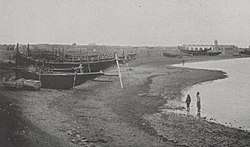
Pearling had come to play a pivotal commercial role in Doha by the 20th century. The population increased to around 12,000 inhabitants in the first half of the 20th century due to the flourishing pearl trade.[37] A British political resident noted that should the supply of pearls drop, Qatar would 'practically cease to exist'.[38] In 1907, the city accommodated 350 pearling boats with a combined crew size of 6,300 men. By this time, the average prices of pearls had more than doubled since 1877.[39] The pearl market collapsed that year, forcing Jassim Al Thani to sell the country's pearl harvest at half its value. The aftermath of the collapse resulted in the establishment of the country's first custom house in Doha.[38]
Lorimer report (1908)
British administrator and historian J. G. Lorimer authored an extensive handbook for British agents in the Persian Gulf entitled Gazetteer of the Persian Gulf in 1908. In it, he gives a comprehensive account of Doha at the time:
.jpg)
Generally so styled at the present day, but Bedouins sometimes call it Dohat-al-Qatar; and it seems to have been formerly better known as Bida' (Anglice "Bidder"): it is the chief town of Qatar and is situated on the eastern side of that peninsula, about 63 miles south of its extremity at Ras Rakan and 45 miles north of Khor-al Odaid Harbour. Dohah stands on the south side of a deep bay at the south-western corner of a natural harbour which is about 3 miles in extent and is protected on the north-east and south-east sides by natural reefs. The entrance, less than a mile wide, is from the east between the points of the reefs; it is shallow and somewhat difficult, and vessels of more than 15 feet draught cannot pass. The soundings within the basin vary from 3 to 5 fathoms and are regular: the bottom is white mud or clay.
Town site and quarters, — The south-eastern point of the bay is quite low but the land on the western side is stony desert 40 or 50 feet above the level of the sea. The town is built up the slope of some rising ground between these two extremes and consists of 9 Fanqs or quarters, which are given below in their order from the east to the west and north: the total frontage of the place upon the sea is nearly 2 miles.[40]

Lorimer goes on to list and describe the districts of Doha, which at the time included the still-existing districts of Al Mirqab, As Salatah, Al Bidda and Rumeilah.[41] Remarking on Doha's appearance, he states:
The general appearance of Dohah is unattractive; the lanes are narrow and irregular the houses dingy and small. There are no date palms or other trees, and the only garden is a small one near the fort, kept up by the Turkish garrison.[42]
As for Doha's population, Lorimer asserts that "the inhabitants of Dohah are estimated to amount, inclusive of the Turkish military garrison of 350 men, to about 12,000 souls". He qualified this statement with a tabulated overview of the various tribes and ethnic groups living in the town.[42]
British protectorate (1916–1971)
In April 1913, the Ottomans agreed to a British request that they withdraw all their troops from Qatar. Ottoman presence in the peninsula ceased, when in August 1915, the Ottoman fort in Al Bidda was evacuated shortly after the start of World War I.[43] One year later, Qatar agreed to be a British protectorate with Doha as its official capital.[44][45]
Buildings at the time were simple dwellings of one or two rooms, built from mud, stone and coral. Oil concessions in the 1920s and 1930s, and subsequent oil drilling in 1939, heralded the beginning of slow economic and social progress in the country. However, revenues were somewhat diminished due to the devaluation of pearl trade in the Persian Gulf brought on by introduction of the cultured pearl and the Great Depression.[46] The collapse of the pearl trade caused a significant population drop throughout the entire country.[37] It was not until the 1950s and 1960s that the country saw significant monetary returns from oil drilling.[14]
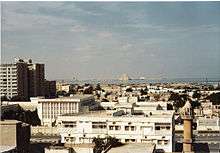
Qatar was not long in exploiting the new-found wealth from oil concessions, and slum areas were quickly razed to be replaced by more modern buildings. The first formal boys' school was established in Doha in 1952, followed three years later by the establishment of a girls' school.[47] Historically, Doha had been a commercial port of local significance. However, the shallow water of the bay prevented bigger ships from entering the port until the 1970s, when its deep-water port was completed. Further changes followed with extensive land reclamation, which led to the development of the crescent-shaped bay.[48] From the 1950s to 1970s, the population of Doha grew from around 14,000 inhabitants to over 83,000, with foreign immigrants constituting about two-thirds of the overall population.[49]
Post-independence
.jpg)
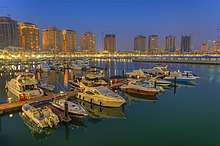
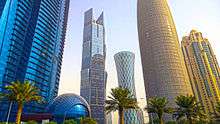
Qatar officially declared its independence in 1971, with Doha as its capital city.[3] In 1973, the University of Qatar was opened by emiri decree,[50] and in 1975 the Qatar National Museum opened in what was originally the ruler's palace.[51] During the 1970s, all old neighborhoods in Doha were razed and the inhabitants moved to new suburban developments, such as Al Rayyan, Madinat Khalifa and Al Gharafa. The metropolitan area's population grew from 89,000 in the 1970s to over 434,000 in 1997. Additionally, land policies resulted in the total land area increasing to over 7,100 hectares (about 17,000 acres) by 1995, an increase from 130 hectares in the middle of the 20th century.[52]
In 1983, a hotel and conference center was developed at the north end of the Corniche. The 15-storey Sheraton hotel structure in this center would serve as the tallest structure in Doha until the 1990s.[52] In 1993, the Qatar Open became the first major sports event to be hosted in the city.[53] Two years later, Qatar stepped in to host the FIFA World Youth Championship, with all the matches being played in Doha-based stadiums.[54]

The Al Jazeera Arabic news channel began broadcasting from Doha in 1996.[55] In the late 1990s, the government planned the construction of Education City, a 2,500 hectare Doha-based complex mainly for educational institutes.[56] Since the start of the 21st century, Doha attained significant media attention due to the hosting of several global events and the inauguration of a number of architectural mega-projects.[57] One of the largest projects launched by the government was The Pearl-Qatar, an artificial island off the coast of West Bay, which launched its first district in 2004.[58] In 2006, Doha was selected to host the Asian Games, leading to the development of a 250-hectare sporting complex known as Aspire Zone.[53] During this time, new cultural attractions were constructed in the city, with older ones being restored. In 2006, the government launched a restoration program to preserve Souq Waqif's architectural and historical identity. Parts constructed after the 1950s were demolished whereas older structures were refurbished. The restoration was completed in 2008.[59] Katara Cultural Village was opened in the city in 2010 and has hosted the Doha Tribeca Film Festival since then.[60]
The main outcome of the World Trade Organization Ministerial Conference of 2013 was the Trade Facilitation Agreement. The agreement aims to make it easier and cheaper to import and export by improving customs procedures and making rules more transparent. Reducing global trade costs by 1% would increase world-wide income more than USD 40 billion, 65% of which would go to developing countries. The gains from the Trade Facilitation Agreement are expected to be distributed among all countries and regions, with developing landlocked countries benefiting the most.[61]
The Trade Facilitation Agreement will enter into force upon its ratification by 2/3 of WTO Members. The EU ratified the agreement in October 2015.[61]
In Bali, WTO members also agreed on a series of Doha agriculture and development issues.[61]
Geography
Doha is located on the central-east portion of Qatar, bordered by the Persian Gulf on its coast. Its elevation is 10 m (33 ft).[62] Doha is highly urbanized. Land reclamation off the coast has added 400 hectares of land and 30 km of coastline.[63] Half of the 22 km² of surface area which Hamad International Airport was constructed on was reclaimed land.[64] The geology of Doha is primarily composed of weathered unconformity on the top of the Eocene period Dammam Formation, forming dolomitic limestone.[65]
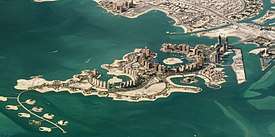
The Pearl is an artificial island in Doha with a surface area of nearly 400 ha (1,000 acres)[66] The total project has been estimated to cost $15 billion upon completion.[67] Other islands off Doha's coast include Palm Tree Island, Shrao's Island, Al Safliya Island, and Alia Island.[68]
In a 2010 survey of Doha's coastal waters conducted by the Qatar Statistics Authority, it was found that its maximum depth was 7.5 meters (25 ft) and minimum depth was 2 meters (6 ft 7 in). Furthermore, the waters had an average pH of 7.83, a salinity of 49.0 psu, an average temperature of 22.7 °C and 5.5 mg/L of dissolved oxygen.[69]
Climate
Doha has a hot desert climate (Köppen climate classification BWh) with long, extremely hot summers and short, warm winters. The average high temperatures between May and September surpass 38 °C (100 °F) and often approach 45 °C (113 °F). Humidity is usually the lowest in May and June. Dewpoints can surpass 30 °C (86 °F) in the summer. Throughout the summer, the city averages almost no precipitation, and less than 20 mm (0.79 in) during other months.[70] Rainfall is scarce, at a total of 75 mm (2.95 in) per year, falling on isolated days mostly between October to March. The winter's days are relativity warm while the sun is up and cool during the night. The temperature rarely drops below 7 °C (45 °F).[71]
| Climate data for Doha (1962–2013, extremes 1962–2013) | |||||||||||||
|---|---|---|---|---|---|---|---|---|---|---|---|---|---|
| Month | Jan | Feb | Mar | Apr | May | Jun | Jul | Aug | Sep | Oct | Nov | Dec | Year |
| Record high °C (°F) | 32.4 (90.3) |
36.5 (97.7) |
39.0 (102.2) |
46.0 (114.8) |
47.7 (117.9) |
49.1 (120.4) |
50.4 (122.7) |
48.6 (119.5) |
46.2 (115.2) |
43.4 (110.1) |
38.0 (100.4) |
32.7 (90.9) |
50.4 (122.7) |
| Average high °C (°F) | 22.0 (71.6) |
23.4 (74.1) |
27.3 (81.1) |
32.5 (90.5) |
38.8 (101.8) |
41.6 (106.9) |
41.9 (107.4) |
40.9 (105.6) |
38.9 (102.0) |
35.4 (95.7) |
29.6 (85.3) |
24.4 (75.9) |
33.1 (91.5) |
| Daily mean °C (°F) | 17.8 (64.0) |
18.9 (66.0) |
22.3 (72.1) |
27.1 (80.8) |
32.5 (90.5) |
35.1 (95.2) |
36.1 (97.0) |
35.5 (95.9) |
33.3 (91.9) |
30.0 (86.0) |
25.0 (77.0) |
20.0 (68.0) |
27.8 (82.0) |
| Average low °C (°F) | 13.5 (56.3) |
14.4 (57.9) |
17.3 (63.1) |
21.4 (70.5) |
26.1 (79.0) |
28.5 (83.3) |
30.2 (86.4) |
30.0 (86.0) |
27.7 (81.9) |
24.6 (76.3) |
20.4 (68.7) |
15.6 (60.1) |
22.5 (72.5) |
| Record low °C (°F) | 3.8 (38.8) |
5.0 (41.0) |
8.2 (46.8) |
10.5 (50.9) |
15.2 (59.4) |
21.0 (69.8) |
23.5 (74.3) |
22.4 (72.3) |
20.3 (68.5) |
16.6 (61.9) |
11.8 (53.2) |
6.4 (43.5) |
3.8 (38.8) |
| Average precipitation mm (inches) | 13.2 (0.52) |
17.1 (0.67) |
16.1 (0.63) |
8.7 (0.34) |
3.6 (0.14) |
0.0 (0.0) |
0.0 (0.0) |
0.0 (0.0) |
0.0 (0.0) |
1.1 (0.04) |
3.3 (0.13) |
12.1 (0.48) |
75.2 (2.95) |
| Average precipitation days (≥ 1.0 mm) | 1.7 | 2.1 | 1.8 | 1.4 | 0.2 | 0.0 | 0.0 | 0.0 | 0.0 | 0.1 | 0.2 | 1.3 | 8.8 |
| Average relative humidity (%) | 74 | 70 | 63 | 53 | 44 | 41 | 50 | 58 | 62 | 63 | 66 | 74 | 60 |
| Mean monthly sunshine hours | 244.9 | 224.0 | 241.8 | 273.0 | 325.5 | 342.0 | 325.5 | 328.6 | 306.0 | 303.8 | 276.0 | 241.8 | 3,432.9 |
| Mean daily sunshine hours | 7.9 | 8.0 | 7.8 | 9.1 | 10.5 | 11.4 | 10.5 | 10.6 | 10.2 | 9.8 | 9.2 | 7.8 | 9.4 |
| Source 1: NOAA[71] | |||||||||||||
| Source 2: Qatar Meteorological Department (Climate Normals 1962–2013)[72] | |||||||||||||
| Doha mean sea temperature[73] | |||||||||||
|---|---|---|---|---|---|---|---|---|---|---|---|
| Jan | Feb | Mar | Apr | May | Jun | Jul | Aug | Sep | Oct | Nov | Dec |
| 20.5 °C (68.9 °F) | 19.1 °C (66.4 °F) | 20.9 °C (69.6 °F) | 23.7 °C (74.7 °F) | 28.2 °C (82.8 °F) | 30.9 °C (87.6 °F) | 32.8 °C (91.0 °F) | 33.9 °C (93.0 °F) | 33.1 °C (91.6 °F) | 31.0 °C (87.8 °F) | 27.4 °C (81.3 °F) | 23.1 °C (73.6 °F) |
Demographics
| Year | Pop. | ±% |
|---|---|---|
| 1820[11] | 250 | — |
| 1893[33] | 6,000 | +2300.0% |
| 1970[74] | 80,000 | +1233.3% |
| 1986[3] | 217,294 | +171.6% |
| 1998[75] | 264,009 | +21.5% |
| 2001[76] | 299,300 | +13.4% |
| 2004[3] | 339,847 | +13.5% |
| 2005[77][78] | 400,051 | +17.7% |
| 2010[79] | 796,947 | +99.2% |
| 2015[2] | 956,457 | +20.0% |
| Total population of the Doha metropolitan area[80] | |
|---|---|
| Year | Metro population |
| 1997 | 434,000[52] |
| 2004 | 644,000[81] |
| 2008 | 998,651[82] |
A significant portion of Qatar's population resides within the confines of Doha and its metropolitan area.[83] The district with the highest population density is the central area of Al Najada, which also accommodates the highest total population in the country. The population density across the greater Doha region ranges from 20,000 people per km² to 25 people per km².[84] Doha witnessed explosive growth rates in population in the first decade of the 21st century, absorbing the majority of the thousands of people then immigrating to Qatar every month.[85]:6 Doha's population is around one million, with the population of the city more than doubling from 2000 to 2010.[2]
Ethnicity and languages
The population of Doha is overwhelmingly composed of expatriates, with Qatari nationals forming a minority. The largest portion of expatriates in Qatar are from South-East and South Asian countries, mainly India, Pakistan, Sri Lanka, Nepal, Philippines, and Bangladesh with large numbers of expatriates also coming from the Levant Arab countries, North Africa, and East Asia. Doha is also home to many expatriates from Europe, North America, South Africa and Australia.[86]

Arabic is the official language of Qatar. English is commonly used as a second language,[87] and a rising lingua franca, especially in commerce.[88] As there is a large expatriate population in Doha, languages such as Malayalam, Tamil, Bengali, Tagalog, Spanish, Sinhala, French, Urdu and Hindi are widely spoken.[86]
| Registered live births in Doha by nationality[80][89] | |||
|---|---|---|---|
| Year | Qatari | Non-Qatari | Total |
| 2001 | 2,080 | 3,619 | 5,699 |
| 2002 | 1,875 | 3,657 | 5,532 |
| 2003 | 2,172 | 4,027 | 6,199 |
| 2004 | 2,054 | 3,760 | 5,814 |
| 2005 | 1,767 | 3,899 | 5,666 |
| 2006 | 1,908 | 4,116 | 6,024 |
| 2007 | 1,913 | 4,708 | 6,621 |
| 2008 | 1,850 | 5,283 | 7,133 |
| 2009 | 2,141 | 5,979 | 8,120 |
| 2010[90] | 1,671 | 5,919 | 7,590 |
| 2011[91] | 1,859 | 6,580 | 8,439 |
In 2004, the Foreign Ownership of Real Estate Law was passed, permitting non-Qatari citizens to buy land in designated areas of Doha, including the West Bay Lagoon, the Qatar Pearl, and the new Lusail City.[57] Prior to this, expatriates were prohibited from owning land in Qatar. Ownership by foreigners in Qatar entitles them to a renewable residency permit, which allows them to live and work in Qatar.[83]
Religion
The majority of residents in Doha are Muslim.[92] Catholics account for over 90% of the 150,000 Christian population in Doha.[93] Following decrees by the Emir for the allocation of land to churches, the first Catholic church, Our Lady of the Rosary, was opened in Doha in March 2008. The church structure is discreet and Christian symbols are not displayed on the outside of the building.[94] Several other churches exist in Doha, including the St.Isaac and St. George Greek Orthodox Church of Qatar the Syro-Malabar Church, Malankara Orthodox Church, Mar Thoma Church (affiliated with the Anglicans, but not part of the Communion), CSI Church, Syro-Malankara Church and a Pentecostal church. A majority of mosques are either Salafi or Sunni-oriented.[95]
Administration
Districts
At the turn of the 20th century, Doha was divided into 9 main districts.[96] In the 2010 census, there were more than 60 districts recorded in Doha Municipality.[97] Some of the districts of Doha include:
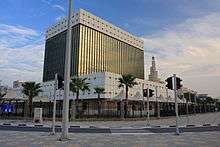
- Al Bidda (البدع)
- Al Dafna (الدفنة)
- Al Ghanim (الغانم)
- Al Markhiya (المرخية)
- Al Sadd (السد)
- Al Waab (الوعب)
- Bin Mahmoud (فريج بن محمود)
- Madinat Khalifa (مدينة خليفة)
- Musheireb (مشيرب)
- Najma (نجمه)
- Old Airport (المطار القديم)
- Qutaifiya (القطيفية)
- Ras Abu Aboud (راس أبو عبود)
- Rumeilah (الرميلة)
- Umm Ghuwailina (ام غو يلينه)
- West Bay (الخليج الغربي)
Shortly after Qatar gained independence, many of the districts of old Doha including Al Najada, Al Asmakh and Old Al Hitmi faced gradual decline and as a result much of their historical architecture has been demolished.[98] Instead, the government shifted their focus toward the Doha Bay area, which housed districts such as Al Dafna and West Bay.[98]
Economy
.jpg)
Doha is the economic center of Qatar. The city is the headquarters of numerous domestic and international organizations, including the country's largest oil and gas companies, Qatar Petroleum, Qatargas and RasGas. Doha's economy is built primarily on the revenue the country has made from its oil and natural gas industries.[99] Doha was included in Fortune's 15 best new cities for business in 2011.[100]
Beginning in the late 20th century, the government launched numerous initiatives to diversify the country's economy in order to decrease its dependence on oil and gas resources. Doha International Airport was constructed in a bid to solidify the city's diversification into the tourism industry.[99] This was replaced by Hamad International Airport in 2014. The new airport is almost twice the size of the former and features two of the longest runways in the world.[101] Thirty-nine new hotels were under construction in the city in 2011.[102]
As a result of Doha's rapid population boom and increased housing demands, real estate prices rose significantly through 2014.[103] Real estate prices experienced a further spike after Qatar won the rights to host the 2022 FIFA World Cup.[104] Al Asmakh, a Qatari real estate firm, released a report in 2014 which revealed substantial increases in real estate prices following a peak in 2008. Prices increased 5 to 10% in the first quarter of 2014 from the end of 2013.[103][105] A 2015 study conducted by Numbeo, a crowd-sourced database, named Doha as the 10th most expensive city to live in globally.[106] This rate of growth led to the development of planned communities in and around the city.[107] Although the fall in oil prices since 2014 and a diplomatic crisis with Qatar's neighbors slowed growth in the city's population, government spending was increased to maintain the growth in real estate in metropolitan Doha.[108]
Expatriate workers remitted $60bn between 2006 and 2012, with 54 percent of the workers' remittances of $60bn routed to Asian countries, followed by Arab nations that accounted for nearly half that volume (28 percent). India was the top destination of the remittances, followed by the Philippines, while the US, Egypt and the neighbouring UAE followed.[109] Remittances in 2014 totaled $11.2 billion, amounting to 5.3% of Qatar's GDP.[110]:45
Infrastructure
Architecture
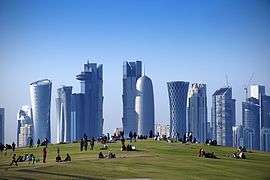
Many of the older structures (1960-1970s) in the Old Doha districts have been demolished to make space for new buildings.[98] A number of schemes have been taken to preserve the city's cultural and architectural heritage, such as the Qatar Museums Authority's 'Al Turath al Hai' ('living heritage') initiative.[111] Katara Cultural Village is a model village in Doha launched by Sheikha Moza bint Nasser under Qatar Foundation to preserve the cultural identity of the country.[112]
.jpg)
In 2011, more than 50 towers were under construction in Doha,[102] the largest of which was the Doha Convention Center Tower.[113] Constructions were suspended in 2012 following concerns that the tower would impede flight traffic[114] and the site is being redeveloped into a park.
In 2014, Abdullah Al Attiyah, a senior government official, announced that Qatar would be spending $65bn on new infrastructure projects in upcoming years in preparation for the 2022 World Cup as well as progressing towards its objectives set out in the Qatar National Vision 2030.[115]
Msheireb Downtown Doha, a 31 hectares development costing an estimated $5bn, was dubbed the largest inner city redevelopment of its kind when launched. Comprises several quarters opened over different phases, Msheireb aims to preserve and enhance the historic downtown area.
Atmosphere
Due to excessive heat from the sun during the summer, some Doha-based building companies have implemented various forms of cooling technology to alleviate the extremely torrid climatic conditions. This can include creating optical phenomena such as shadows, as well as more expensive techniques like ventilation, coolants, refrigerants, cryogenics, and dehumidifiers.[116] Discussions regarding temperature control have also been features of various scheduled events involving large crowds.[117] There are other initiatives that attempt to counter the heat by altering working hours, weather alteration methods such as cloud seeding,[118][119] and using whiter and brighter construction materials to increase the albedo effects.[120] Nonetheless, despite these measures, Doha and other areas of Qatar could become uninhabitable for humans due to climate change by the 2070s.[121]
Planned communities
One of the largest projects underway in Qatar is Lusail City, a planned community north of Doha which is estimated to be completed by 2020 at a cost of approximately $45bn. It is designed to accommodate 450,000 people.[122] Al Waab City, another planned community under development, is estimated to cost QR15 bn.[123] In addition to housing 8,000 individuals, it will also have shopping malls, educational, and medical facilities.[123] Gewan Island is the latest development of UDC comprising a 400,000 sqm mixed use development.
Transportation
To support the expanding city and increasing numbers of residents and commuters, Qatar has heavily invested in upgrading the infrastructure of Doha and Qatar. Since 2004, Doha has been undergoing a huge expansion to its transportation network, including the addition of new highways, a new airport in 2014, a new seaport in 2016, and an 85 km metro system which went operational in 2019.[124]
Roads
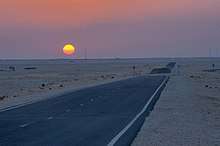
Several expressway projects were delivered by ASHGHAL or the Public Works Authority, including Industrial Area Road, Doha Expressway, Dukhan Highway Central, North Road, Al Sheehaniya Leatooriya Lijmiliya Road, F-Ring Road, and Salwa Road Phase 2. Works includes road widening, underpasses, interchanges, storm water drainage systems, effluent networks, systems networks and lighting to improve road travel use and improved safety for all road users.
The latest project, expected to be delivered in 2024 is the Sharq Crossing:
"The estimated $12bn Sharq Crossing undertaking will involve three extensions interconnected by subsea tunnels. As per the original design, the intersection will incorporate three scaffolds spreading over between 600 meters and 1,310 meters, connecting Doha’s Hamad International Airport with the city’s social locale of Katara Cultural Village in the north and the focal business territory of West Bay."
Rail
The Doha Metro is fully operational and consists of four lines: the Red Line, the Gold Line, the Blue Line and the Green Line. The Blue Line is expected to be completed in the second phase in 2025.[126] Msheireb Station is the transfer station for all of the metro lines.[124]

The Red Line (also known as Coast Line) will extend through Doha, running from Al Khor to Al Wakrah and Hamad Airport via the Red Line North and Red Line South. Doha Metro's Green Line, or Education Line, connects Doha to Education City and Al Riffa. Starting in Old Airport, the Gold Line (also known as Historic Line) will end in Al Rayyan and cover a distance of 30.6 km. Lastly, the Blue Line, or City Line, will only cover the inner city of Doha, and is planned to be semi-circular with a length of 17.5 km.[127]
Air
Doha is served by Hamad International Airport which is Qatar's principal international gateway. The airport opened in 2014, replacing Doha International Airport.
Education
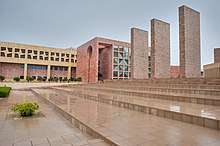
Doha is the educational center of the country and contains the highest preponderance of schools and colleges.[74] In 1952, the first formal boys' school was opened in Doha. This was proceeded by the opening of the first formal girls' school three years later.[128] The first university in the state, Qatar University, was opened in 1973.[129] It provided separate faculties for men and women.[130]
Education City, a 14 km2 education complex launched by non-profit organization Qatar Foundation, began construction in 2000.[131] It houses eight universities, the country's top high school, and offices for Al Jazeera's children television channel.[131] It is geographically located in Al Rayyan municipality's Al Luqta, Al Gharrafa, Gharrafat Al Rayyan and Al Shagub districts, but falls under the umbrella of Metropolitan Doha.[6]
In 2009, the government launched the World Innovation Summit for Education (WISE), a global forum that brings together education stakeholders, opinion leaders and decision makers from all over the world to discuss educational issues.[132] The first edition was held in Doha in November 2009.[133]
Some of the universities in Doha include:
- Carnegie Mellon University in Qatar
- Georgetown University School of Foreign Service in Qatar
- Hamad Bin Khalifa University
- Cornell University[134]
- HEC Paris
- Northwestern University in Qatar
- Texas A&M University at Qatar
- UCL Qatar[135]
- Virginia Commonwealth University
- Weill Cornell Medical College in Qatar
- Stenden University Qatar
- College of the North Atlantic
- Qatar University
- Qatar Faculty of Islamic Studies
- University of Calgary
Sports
Football
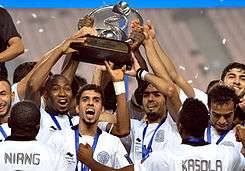
Football is the most popular sport in Doha. There are six Doha-based sports clubs with football teams competing in the Qatar Stars League, the country's top football league. They are Al Ahli, Al Arabi, Al Sadd, Al-Duhail and Qatar SC.[136] Al Sadd, Al Arabi and Qatar SC are the three most successful teams in the league's history.[137]
Numerous football tournaments have been hosted in Doha. The most prestigious tournaments include the 1988 and 2011 editions of the AFC Asian Cup[138] and the 1995 FIFA World Youth Championship.[54]
In December 2010, Qatar won the rights to host the 2022 FIFA World Cup.[139] Three of the nine newly announced stadiums will be constructed in Doha, including Sports City Stadium, Doha Port Stadium, and Qatar University Stadium. Additionally, the Khalifa International Stadium is set to undergo an expansion.[140]
Considering the country's rapid development for 2022 World Cup, FIFA awarded the hosting rights of 2019 FIFA Club World Cup and 2020 FIFA Club World Cup also to Qatar.[141]
Basketball
Doha was the host of the official 2005 FIBA Asia Championship, where Qatar's national basketball team finished 3rd, its best performance to date, and subsequently qualified for the Basketball World Cup.[142]
The majority of the teams that make up the official Qatari Basketball League are based in Doha.
Volleyball
Doha four times was the host of the official FIVB Volleyball Men's Club World Championship and three times host FIVB Volleyball Women's Club World Championship. Doha one time Host Asian Volleyball Championship.[143]
Other sports
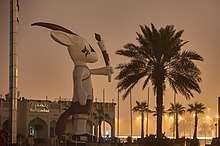
In 2001, Qatar became the first country in the Middle East to hold a women's tennis tournament with the inauguration of its Qatar Ladies Open tournament.[144] Doha also hosts International Tennis Federation (ITF) ladies tournaments. Since 2008, the Sony Ericsson Championships (equivalent to the ATP's season-ending Championships) has taken place in Doha, in the Khalifa International Tennis Complex, and features record prize money of $4.45 million, including a check of $1,485,000 for the winner, which represents the largest single guaranteed payout in women's tennis.[145]
Doha hosted the 15th Asian Games, held in December 2006, spending a total of $2.8 billion for its preparation.[146] The city also hosted the 3rd West Asian Games in December 2005.[147] Doha was expected to host the 2011 Asian Indoor Games; but the Qatar Olympic Committee cancelled the event.[148]
.jpg)
The city submitted a bid for the 2016 Olympics.[149] On June 4, 2008, the city was eliminated from the shortlist for the 2016 Olympic Games. On August 26, 2011 it was confirmed that Doha would bid for the 2020 Summer Olympics.[150] Doha however failed to become a Candidate City for the 2020 Games.[151]
The MotoGP motorcycling grand prix of Doha is held annually at Losail International Circuit, located just outside the city boundaries.[152] The city is also the location of the Grand Prix of Qatar for the F1 Powerboat World Championship, annually hosting a round in Doha Bay.[153] Beginning in November 2009, Doha has been host of The Oryx Cup World Championship, a hydroplane boat race in the H1 Unlimited season. The races take place in Doha Bay.[154]
In April 2012 Doha was awarded both the 2014 FINA World Swimming Championships[155] and the 2012 World Squash Championships.[156] The fourth World Mindsports Championships took place in Doha from August 19 to August 27, 2017 with the participation of more than 1,000 competitors.[157]
In 2014, Qatar was selected as the host of the 2019 World Athletics Championships, which is the seventeenth edition of the IAAF World Athletics Championships.[158] Doha won the bid to host the event over Barcelona and Eugene.[159]
In 2020, Doha hosted the Qatar ExxonMobil Open, which received the Tournament of the Year award in the 250 category from the 2019 ATP Awards. The tournament won the award for the third time in five years.[160]
Stadiums and sport complexes
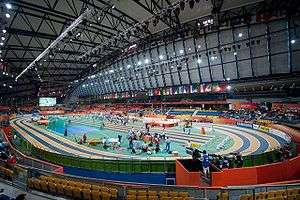
Aspire Academy was launched in 2004 with the aim of creating world-class athletes. It is situated in the Doha Sports City Complex, which also accommodates the Khalifa International Stadium, the Hamad Aquatic Centre, the Aspire Tower and the Aspire Dome. The latter has hosted more than 50 sporting events since its inception, including some events during the 2006 Asian Games.[161]
Sporting venues in Doha and its suburbs include:
- Hamad bin Khalifa Stadium – Al-Ahli Stadium
- Jassim Bin Hamad Stadium (Al Sadd Stadium)
- Al-Arabi Stadium – Grand Hamad Stadium
- Hamad Aquatic Centre
- Khalifa International Stadium – Main venue for the 2006 Asian Games.
- Khalifa International Tennis and Squash Complex
- Qatar Sports Club Stadium
Culture
Doha was chosen as the Arab Capital of Culture in 2010.[162] Cultural weeks organized by the Ministry of Culture, which featured both Arab and non-Arab cultures, were held in Doha from April to June to celebrate the city's selection.[163]
Arts
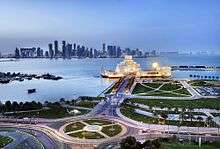
The Museum of Islamic Art or MIA in Doha, opened in 2008, is regarded as one of the best museums in the region.[165] This, and several other Qatari museums located in the city, like the Arab Museum of Modern Art, falls under the Qatar Museums Authority (QMA) which is led by Sheikha Al-Mayassa bint Hamad bin Khalifa Al-Thani, the sister of the emir of Qatar.[166]
The National Museum of Qatar, which was constructed in place of the original Qatar National Museum, opened to the public on 28 March 2019.
Cinema
The Doha Film Institute (DFI) is an organisation established in 2010 to oversee film initiatives and create a sustainable film industry in Qatar. DFI was founded by H.E. Sheikha Al Mayassa bint Hamad bin Khalifa Al-Thani.[167]
The Doha Tribeca Film Festival (DTFF), partnered with the American-based Tribeca Film Festival, was held annually in Doha from 2009 to 2012.[168]
Media
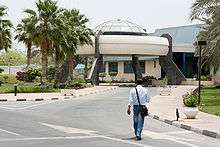
Qatar's first radio station, Mosque Radio, began broadcasting in the 1960s from Doha.[169] The multinational media conglomerate Al Jazeera Media Network is based in Doha with its wide variety of channels of which Al Jazeera Arabic, Al Jazeera English, Al Jazeera Documentary Channel, Al Jazeera Mubasher, beIN Sports Arabia and other operations are based in the TV Roundabout in the city.[170] Al-Kass Sports Channel's headquarters is also located in Doha.[171]
Theatre
Theatre was introduced to Qatar in the mid-20th century. Theatrical performances are held at Qatar National Theater and at the Qatar National Convention Center in Doha.
International relations






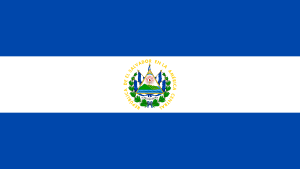
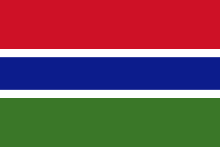


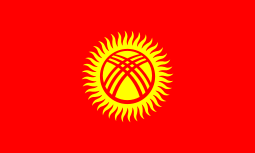
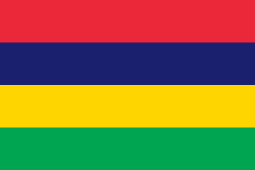
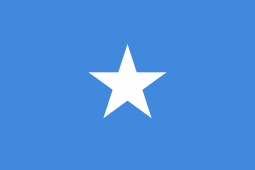
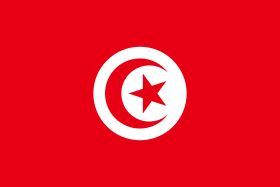




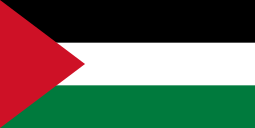
Gallery
Click on the thumbnail to enlarge.
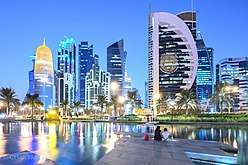 Skyline of Doha West Bay from Sheraton Park.
Skyline of Doha West Bay from Sheraton Park.- The spring festival at Souq Waqif, Doha
- An old mosque minaret stands out in front of the under-construction National Archive building in the Diwan Amiri Quarter of the Musheireb downtown Doha development.
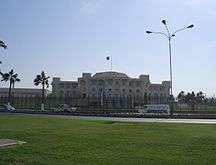 Qatar's Amir (ruler) is housed in the Amiri Diwan located in the historic Al Bidda district.
Qatar's Amir (ruler) is housed in the Amiri Diwan located in the historic Al Bidda district.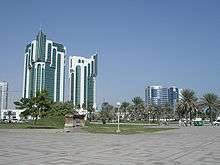 These twin towers are among the earliest towers in Doha and serve as a great example of post-modern architecture.
These twin towers are among the earliest towers in Doha and serve as a great example of post-modern architecture. Msheireb Enrichment Centre moored off Doha Corniche is a learning center focused on the history and developments of Doha, particularly the Musheirib district.
Msheireb Enrichment Centre moored off Doha Corniche is a learning center focused on the history and developments of Doha, particularly the Musheirib district.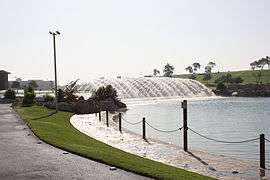 Aspire Park, Al Waab is one of the city's green spaces that forms a part of the Aspire zone.
Aspire Park, Al Waab is one of the city's green spaces that forms a part of the Aspire zone. Doha skyline from the Museum of Islamic Art.
Doha skyline from the Museum of Islamic Art.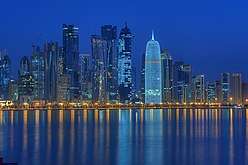 Doha skyline at night.
Doha skyline at night. Doha Corniche is the 7 km long water front that connects the new district of West Bay with the old district of Al-Bidda and Al-Souq on the other end.
Doha Corniche is the 7 km long water front that connects the new district of West Bay with the old district of Al-Bidda and Al-Souq on the other end.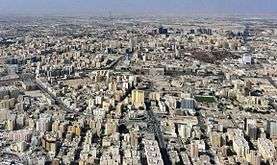 Aerial view of a part of the city.
Aerial view of a part of the city.- The Katara cultural village is designed to be a hub of human interaction connecting theatre, literature, music, visual art, conventions and exhibitions in a planned development on the waterfront.[191]
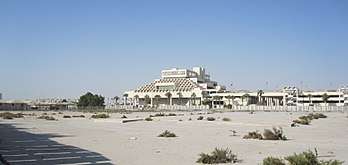 The post office building in Qatar sits located on the main Corniche street.
The post office building in Qatar sits located on the main Corniche street.
See also
- Doha Declaration
- Doha Development Round of World Trade Organization (WTO) talks
- Qatar National Day which is held in Doha every year on December 18
References
- "Doha municipality accounts for 40% of Qatar population". Gulf Times. 20 October 2015. Retrieved 23 October 2015.
- The Report: Qatar 2016. Oxford Business Group. 2016. p. 17. ISBN 9781910068632.
- Encyclopædia Britannica. "Doha – Britannica Online Encyclopedia". Britannica.com. Retrieved 2010-06-27.
- "Welcome to the 20th World Petroleum Congress". 20wpc.com. Retrieved 2013-07-29.
- Saraiva, Alexia. "Get To Know The 8 2022 Qatar World Cup Stadiums". ArchDaily.
- "District map". The Centre for Geographic Information Systems of Qatar. Retrieved 29 May 2018.
- "Historical references to Doha and Bidda before 1850" (PDF). The Origins of Doha Project. p. 1. Retrieved 19 May 2015.
- Billecocq, Xavier Beguin (2003). Le Qatar et les Français: cinq siècles de récits de voyage et de textes d'érudition. Collection Relations Internationales & Culture. ISBN 9782915273007.
- Rahman, Habibur (2006). The Emergence Of Qatar. Routledge. p. 34. ISBN 978-0710312136.
- Carter, Robert. "Origins of Doha Season 1 Archive Report". academia.edu. p. 11. Retrieved 13 March 2015.
- "Historical references to Doha and Bidda before 1850" (PDF). The Origins of Doha Project. p. 2. Retrieved 19 May 2015.
- Al-Qasimi, Sultan Mohammed (1995). The journals of David Seton in the Gulf 1800-1809. Exeter University Press.
- H. Rahman (2006), p. 36.
- Toth, Anthony. "Qatar: Historical Background." A Country Study: Qatar (Helen Chapin Metz, editor). Library of Congress Federal Research Division (January 1993). This article incorporates text from this source, which is in the public domain.
- "Historical references to Doha and Bidda before 1850" (PDF). The Origins of Doha Project. p. 3. Retrieved 19 May 2015.
- "'Gazetteer of the Persian Gulf. Vol I. Historical. Part IA & IB. J G Lorimer. 1915' [793] (948/1782)". qdl.qa. Retrieved 28 January 2015.
- "Historical references to Doha and Bidda before 1850" (PDF). The Origins of Doha Project. p. 4. Retrieved 19 May 2015.
- H. Rahman (2006), p. 63.
- "Historical references to Doha and Bidda before 1850" (PDF). The Origins of Doha Project. p. 5. Retrieved 19 May 2015.
- Brucks, G. B. (1985). Memoir descriptive of the Navigation of the Gulf of Persia in R. H. Thomas (ed.) Selections from the records of the Bombay Government No XXIV (1829). New York: Oleander press.
- Zahlan, Rosemarie Said (1979). The creation of Qatar (print ed.). Barnes & Noble Books. p. 33. ISBN 978-0064979658.
- "'Gazetteer of the Persian Gulf. Vol I. Historical. Part IA & IB. J G Lorimer. 1915' [794] (949/1782)". qdl.qa. Retrieved 28 January 2015.
- "Historical references to Doha and Bidda before 1850" (PDF). The Origins of Doha Project. pp. 5–6. Retrieved 19 May 2015.
- H. Rahman (2006), pp. 90–92.
- "Historical references to Doha and Bidda before 1850" (PDF). The Origins of Doha Project. p. 6. Retrieved 19 May 2015.
- "Historical references to Doha and Bidda before 1850" (PDF). The Origins of Doha Project. p. 7. Retrieved 19 May 2015.
- "Line of succession: The Al Thani rule in Qatar". Gulf News. 27 June 2013. Retrieved 14 June 2015.
- "'A collection of treaties, engagements and sanads relating to India and neighbouring countries [...] Vol XI containing the treaties, & c., relating to Aden and the south western coast of Arabia, the Arab principalities in the Persian Gulf, Muscat (Oman), Baluchistan and the North-West Frontier Province' [113v] (235/822)". Qatar Digital Library. Retrieved 12 January 2015.
- "'File 19/243 IV Zubarah' [8r] (15/322)". Qatar Digital Library. Retrieved 12 January 2015.
- "'Gazetteer of the Persian Gulf. Vol I. Historical. Part IA & IB. J G Lorimer. 1915' [801] (956/1782)". Qatar Digital Library. Retrieved 14 June 2015.
- H. Rahman (2006), p. 123.
- H. Rahman (2006), pp. 138–139.
- Kurşun, Zekeriya (2002). The Ottomans in Qatar : a history of Anglo-Ottoman conflicts in the Persian Gulf. Istanbul : Isis Press. pp. 16–17. ISBN 9789754282139.
- Zahlan, Rosemarie Said (1979). The creation of Qatar (print ed.). Barnes & Noble Books. p. 53. ISBN 978-0064979658.
- H. Rahman (2006), p. 152.
- "Historical references to Doha and Bidda before 1850" (PDF). The Origins of Doha Project. p. 11. Retrieved 19 May 2015.
- Florian Wiedmann, Ashraf M. Salama, Alain Thierstein. "Urban evolution of the city of Doha: an investigation into the impact of economic transformations on urban structures" (PDF). p. 38. Retrieved 14 June 2015.CS1 maint: uses authors parameter (link)
- Althani, Mohamed (2013). Jassim the Leader: Founder of Qatar. Profile Books. p. 35. ISBN 978-1781250709.
- Casey, Paula; Vine, Peter (1991). The heritage of Qatar (print ed.). Immel Publishing. pp. 49–50. ISBN 978-0907151500.
- "'Gazetteer of the Persian Gulf. Vol. II. Geographical and Statistical. J G Lorimer. 1908' [487] (536/2084)". Qatar Digital Library. Retrieved 14 January 2019. This article incorporates text from this source, which is in the public domain.
- "'Gazetteer of the Persian Gulf. Vol. II. Geographical and Statistical. J G Lorimer. 1908' [488] (537/2084)". Qatar Digital Library. Retrieved 14 January 2019.
- "'Gazetteer of the Persian Gulf. Vol. II. Geographical and Statistical. J G Lorimer. 1908' [489] (540/2084)". Qatar Digital Library. Retrieved 14 January 2019. This article incorporates text from this source, which is in the public domain.
- M. Althani (2013), p, 134.
- H. Rahman (2006), p. 291.
- "Historical references to Doha and Bidda before 1850" (PDF). The Origins of Doha Project. p. 16. Retrieved 19 May 2015.
- "Pearl Diving in Qatar". USA Today. Retrieved 14 June 2015.
- Abu Saud, Abeer (1984). Qatari Women: Past and Present. Longman Group. p. 173. ISBN 978-0582783720.
- "Qatar in perspective: an orientation guide" (PDF). Defense League Institute Foreign Language Center. 2010. p. 8. Archived from the original (PDF) on 2012-12-10. Retrieved 2015-06-15.
- Florian Wiedmann, Ashraf M. Salama, Alain Thierstein. "Urban evolution of the city of Doha: an investigation into the impact of economic transformations on urban structures" (PDF). p. 41. Retrieved 14 June 2015.CS1 maint: uses authors parameter (link)
- "Our history". Qatar University. Retrieved 14 June 2015.
- "Qatar's National Museum eyeing 2016 opening". Doha News. 6 July 2014. Retrieved 14 June 2015.
- Florian Wiedmann, Ashraf M. Salama, Alain Thierstein. "Urban evolution of the city of Doha: an investigation into the impact of economic transformations on urban structures" (PDF). pp. 44–45. Retrieved 14 June 2015.CS1 maint: uses authors parameter (link)
- Florian Wiedmann, Ashraf M. Salama, Alain Thierstein. "Urban evolution of the city of Doha: an investigation into the impact of economic transformations on urban structures" (PDF). p. 47. Retrieved 14 June 2015.CS1 maint: uses authors parameter (link)
- "FIFA World Youth Championship Qatar 1995 – matches". FIFA. Retrieved 14 June 2015.
- "AL JAZEERA TV: The History of the Controversial Middle East News Station Arabic News Satellite Channel History of the Controversial Station". Allied-media. Retrieved 14 June 2015.
- Florian Wiedmann, Ashraf M. Salama, Alain Thierstein. "Urban evolution of the city of Doha: an investigation into the impact of economic transformations on urban structures" (PDF). p. 49. Retrieved 14 June 2015.CS1 maint: uses authors parameter (link)
- Wiedmann, Florian; Salama, Ashraf M (2013). Demystifying Doha: On Architecture and Urbanism in an Emerging City. Ashgate. ISBN 9781409466345.
- Khalil Hanware (21 March 2005). "Pearl-Qatar Towers Lure International Investors". Arab News. Jeddah. Retrieved 11 October 2015.
- Exell, Karen; Rico, Trinidad (2014). Cultural Heritage in the Arabian Peninsula: Debates, Discourses and Practices. Ashgate. p. 199. ISBN 978-1-4094-7009-0.
- Elspeth Black. "Katara: The Cultural Village". The Culture Trip. Retrieved 14 June 2015.
- "Doha Development Agenda - Trade - European Commission". ec.europa.eu. Retrieved 16 October 2019.

- "Map of Doha, Qatar". Climatemps.com. Retrieved 15 June 2015.
- "New land by the sea: Economically and socially, land reclamation pays" (PDF). International Association of Dredging Companies. p. 4. Retrieved 15 June 2015.
- "DEME: Doha Airport Built on Reclaimed Land Becomes Fully Operational". Dredging Today. 3 June 2014. Retrieved 15 June 2015.
- Ed Blinkhorn (April 2015). "Geophysical GPR Survey" (PDF). The Origins of Doha Project. Retrieved 15 June 2015.
- Ron Gluckman (May 2008). "Artificial Islands: In Dubai, a world, and universe of new real estate". Gluckman. Retrieved 15 June 2015.
- "Say Hello To Pearl Qatar – The World's Most Luxurious Artificial Island". Wonderful Engineering. Retrieved 15 June 2015.
- "Qatar islands". Online Qatar. Archived from the original on 18 November 2015. Retrieved 15 June 2015.
- "Qatar Infrastructure Statistics" (PDF). Qatar Statistics Authority. May 2012. p. 29. Retrieved 18 March 2019.
- "Doha weather information". Wunderground.com. 2010-06-10. Retrieved 2010-06-27.
- "Doha International Airport Climate Normals 1962-1992". National Oceanic and Atmospheric Administration. Retrieved September 29, 2016.
- "Climate Information For Doha". Qatar Meteorological Department. Retrieved November 27, 2016.
- "Monthly Doha water temperature chart". Seatemperatures.org. Retrieved 2014-01-20.
- Abdulla Juma Kobaisi. "The Development of Education in Qatar, 1950–1970" (PDF). Durham University. p. 11. Retrieved 17 June 2015.
- Hassan Khayat, Ismail Amer, Saleh Arifi, Ahmed Babaker, Bassam Nasr, Nizam Shafei, Fatimah Al Kuwari, Ali Ibrahim Sheib, Mohammed Khazemi, Nasser Fakhro, Mohammed Al Kuwari (1998). "موسوعة المعلومات القطرية (Qatar Information Encyclopedia)" (in Arabic). Qatar University. p. 235.CS1 maint: uses authors parameter (link)
- "Doha". Tiscali.co.uk. 1984-02-21. Archived from the original on 2009-11-05. Retrieved 2010-06-27.
- "Sheraton Doha Hotel & Resort | Hotel discount bookings in Qatar". Hotelrentalgroup.com. Archived from the original on 2010-08-19. Retrieved 2010-06-27.
- "hotelsdoha.eu". hotelsdoha.eu. Archived from the original on 2013-06-09. Retrieved 2013-03-26.
- "Qatar population statistics". geohive.com. Archived from the original on 14 June 2015. Retrieved 15 June 2015.
- "Population statistics". Qatar Information Exchange. Archived from the original on 1 July 2015. Retrieved 15 June 2015.
- World and Its Peoples. Marshall Cavendish. 2006. p. 61. ISBN 9780761475712.
- "Doha 2016 Summer Olympic Games Bid". GamesBids.com. Archived from the original on 2010-07-04. Retrieved 2010-06-27.
- Marco Dilenge. "Dubai and Doha: Unparalleled Expansion" (PDF). Crown Records Management UK. Retrieved 15 June 2015.
- "Facts and figures". lusail.com. Retrieved 15 June 2015.
- De Bel-Air, Françoise (2017). Demography, Migration, and the Labour Market in Qatar (PDF) (Report). European University Institute and the Gulf Research Center. GLMM - EN - No. 3/2017. Archived (PDF) from the original on 2019-12-28. Retrieved 2020-03-21.
- Humaira Tasnim, Abhay Valiyaveettil, Dr. Ingmar Weber, Venkata Kiran Garimella. "Socio-geographic map of Doha". Qatar Computing Research Institute. Archived from the original on 5 March 2016. Retrieved 15 June 2015.CS1 maint: uses authors parameter (link)
- Baker, Colin; Jones, Sylvia Prys (1998). Encyclopedia of Bilingualism and Bilingual Education. Multilingual Matters. p. 429. ISBN 978-1853593628.
- Guttenplan, D. D. (11 June 2012). "Battling to Preserve Arabic From English's Onslaught". The New York Times. Retrieved 24 November 2013.
- "WELCOME TO Qatar Statistics Authority WEBSITE :". Qsa.gov.qa. Archived from the original on 2008-08-21. Retrieved 2013-03-26.
- "Births and deaths in 2010" (PDF). Qatar Information Exchange. Qatar Statistics Authority. Archived from the original (PDF) on 9 May 2015. Retrieved 3 May 2015.
- "Births and deaths in 2011" (PDF). Qatar Information Exchange. Qatar Statistics Authority. Archived from the original (PDF) on 23 September 2016. Retrieved 3 May 2015.
- "Religious demography of Qatar" (PDF). US Department of State. Retrieved 15 June 2015.
- Shabina Khatri (20 June 2008). "Qatar opens first church, quietly". Al Jazeera. Retrieved 15 June 2015.
- Sonia Verma (14 March 2008). "Qatar hosts its first Christian church". The Times. Retrieved 15 June 2015.
- Oman Economic and Development Strategy Handbook, International Business Publications, USA - 2009, page 40
- Jaidah, Ibrahim; Bourennane, Malika (2010). The History of Qatari Architecture 1800-1950. Skira. p. 25. ISBN 978-8861307933.
- "Census 2010". Qatar Statistics Authority. 2010. Archived from the original on 9 July 2010. Retrieved 2013-07-25.
- Djamel Bouassa. "Al Asmakh historic district in Doha, Qatar: from an urban slum to living heritage". Academia.edu. Retrieved 10 July 2015.
- Michael Dumper, Bruce E. Stanley (2006). Cities of the Middle East and North Africa: A Historical Encyclopedia. ABC-CLIO. p. 138. ISBN 978-1576079195.CS1 maint: uses authors parameter (link)
- Dawsey, Josh; Arora, Rupali. "Global 500 2011: 15 best new cities for business". CNN Money (Interactive map requiring Adobe Flash Player.). Retrieved 2013-03-26.
- Marco Rinaldi (5 May 2014). "Hamad International Airport by Hok". aasarchitecture.com. Retrieved 10 July 2015.
- Bullivant, Lucy (2012). Masterplanning Futures. Routledge. p. 59. ISBN 978-0415554473.
- Peter Kovessy (23 June 2014). "Reports: Housing supply not keeping up with population rise". Doha News. Retrieved 10 July 2015.
- Rohan Soman (13 May 2013). "Real estate prices in Qatar skyrocket". BQ Doha. Archived from the original on 12 July 2015. Retrieved 10 July 2015.
- "Qatar Real Estate Report Q1 2014" (PDF). Al Asmakh Real Estate Firm. 2014. Archived from the original (PDF) on 22 March 2015. Retrieved 10 July 2015.
- Neha Batia (5 July 2015). "Doha city rents are world's tenth most expensive". Construction Week Online. Retrieved 10 July 2015.
- "Falling oil prices and real estate markets". BQ Doha. 10 March 2015. Archived from the original on 12 July 2015. Retrieved 10 July 2015.
- Kerr, Simeon (17 October 2019). "Qatar pins growth hopes on domestic renewal". Financial Times. Retrieved 2020-03-21.
- "Expatriates Remit $60bn in 7 years". Archived from the original on 2013-06-16. Retrieved 2013-05-06.
- World Bank Group (2016). Migration and Remittances Factbook 2016 (3rd ed.). World Bank. doi:10.1596/978-1-4648-0319-2. ISBN 9781464803208.
- "The Winners of the Old Doha Prize Competition Announced". Marhaba. 26 November 2013. Retrieved 10 July 2015.
- "About us". Katara. Archived from the original on 22 July 2015. Retrieved 17 July 2015.
- "The World's Tallest Buildings". Bloomberg. 2010. Retrieved 10 July 2015.
- "Flight concerns stop 550m Doha tower development". Construction Week Online. 31 January 2012. Retrieved 10 July 2015.
- "Doha rolling out the dough for Qatar infrastructure, set to launch new projects worth $65 billion". Al Bawaba. 17 March 2014. Retrieved 17 July 2015.
- Air Conditioning: A Practical Introduction - Page 106, David V. Chadderton - 2014
- The Report: Qatar 2012 - Page 187, Oxford Business Group
- Red Sea and the Persian Gulf - Page 237, 2007
- Sixth Conference on Planned and Inadvertent Weather Modification, p 307, 1977
- Hegazy, Ahmed (2016). Plant Ecology in the Middle East. p. 205.
- "Qatar Could Become Too Hot for Humans Just 50 Years After the 2022 World Cup". Inverse.com. Retrieved 12 August 2018.
- Tony Manfred (22 September 2014). "Qatar Is Building A $45 Billion City From Scratch For The World Cup That It Might Lose". Business Insider. Retrieved 17 July 2015.
- "Al Waab City Phase 1 Opens". Qatar Today Online. 11 March 2014. Archived from the original on 21 July 2015. Retrieved 17 July 2015.
- William Skidmore (24 October 2012). "Qatar's key infrastructure projects". Construction Week Online. Retrieved 17 July 2015.
- "Sharq Crossing re-launch affirms Qatar's long-term growth". www.thepeninsulaqatar.com. Retrieved 2020-07-22.
- "Laying the foundations in Qatar". Trenchless International. 4 July 2017. Retrieved 2 September 2018.
- "Doha Metro". Railway Technology. Retrieved 2 September 2018.
- Abu Saud, Abeer (1984). Qatari Women: Past and Present. Longman Group. p. 173. ISBN 978-0582783720.
- "Qatar University". Qatar e-government. Retrieved 27 May 2015.
- Abu Saud (1973), p. 173
- Simeon Kerr (20 October 2013). "Doha's Education City is a boost for locals". Financial Times. Retrieved 17 July 2015.
- "World Innovation Summit for Education (WISE) 2014". UNESCO. Retrieved 25 June 2015.
- "The 2009 World Innovation Summit for Education (WISE) convened November 16-18, in Doha, Qatar under the theme "Global Education: Working Together for Sustainable Achievements"". WISE Qatar. Archived from the original on 5 April 2017. Retrieved 25 June 2015.
- "While U.S. universities see dollar signs in Qatari partnerships, some cry foul". Gulf News Journal. 24 September 2015. Retrieved 2 October 2015.
- "UCL - London's Global University". UCL Qatar. Retrieved 12 August 2018.
- "Qatar Stars League 2014/2015 » Teams". worldfootball.net. Retrieved 19 July 2015.
- "Qatar Stars League » Champions". worldfootball.net. Retrieved 19 July 2015.
- "AFC Asian Cup history". AFC Asian Cup. Retrieved 19 July 2015.
- "2018 and 2022 FIFA World Cup Hosts Announced". BBC News. 2 December 2010. Retrieved 19 July 2015.
- "2022 FIFA World Cup Bid Evaluation Report: Qatar" (PDF). FIFA. 2010-12-05.
- "Qatar to host next two FIFA Club World Cups". Al Jazeera. Retrieved 3 June 2019.
- 2005 FIBA Asia Championship, ARCHIVE.FIBA.com, Retrieved 5 June 2016.
- "QVA - Qatar Volleyball Association". QVA. Retrieved 12 August 2018.
- "History & Overview". Qatar Tennis Federation. Retrieved 22 August 2018.
- ""Season to End in Doha 2008–2010" on the Sony Ericsson WTA Tour website". Sonyericssonwtatour.com. Retrieved 2013-07-29.
- Patrick Dixon. "The Future Of Qatar – Rapid Growth". globalchange.com. Retrieved 19 July 2015.
- "Doha 2005: 3rd West Asian Games". Olympic Council of Asia. Archived from the original on 5 August 2016. Retrieved 19 July 2015.
- "Qatar Participates in 4th Asian Indoor and Martial Arts Games This Week". Marhaba. 30 June 2013. Retrieved 19 July 2015.
- "Information on 2016 Olympic Games Bids". Gamesbids.com. Retrieved 2010-06-27.
- "Doha to bid for 2020 Olympics". Espn.go.com. 2011-08-26. Retrieved 2013-07-29.
- "IOC selects three cities as Candidates for the 2020 Olympic Games". Olympic.org. Retrieved 2013-07-29.
- "About the circuit". MotoGP. Retrieved 19 July 2015.
- "Power boats". Oryx in-flight magazine. Retrieved 19 July 2015.
- "2014 Oryx Cup Dates Announced". H1 Unlimited. 12 March 2014. Retrieved 19 July 2015.
- "Doha awarded 2014 World Short Course Swimming Championships". Insidethegames.biz. 2012-04-04. Retrieved 2013-07-29.
- "Doha picked to host 2012 World Squash Championships". Insidethegames.biz. 2012-04-18. Retrieved 2013-07-29.
- "World Mindsports Championships ends on high note". The Peninsula. 29 August 2017. Retrieved 22 August 2018.
- "Iaaf WC 2019 will be held in Doha, Qatar!". Retrieved 18 November 2014.
- "Barcelona, Doha and Eugene – candidate cities for 2019 IAAF World Championships". Retrieved 15 April 2014.
- "Doha Honored With ATP 250 Tournament Of The Year Award". ATP Tour. Retrieved 11 January 2020.
- "The Aspire Dome, centre stage for Doha 2010". IAAF Athletics. 3 November 2009. Retrieved 19 July 2015.
- "Irina Bokova receives the Prize 'Doha 2010 Arab Capital of Culture'". UNESCO. 17 December 2010. Retrieved 22 July 2015.
- "Doha, 2010 Arab culture capital, to host Arab and non-Arab cultural weeks". Habib Toumi. 4 April 2010. Retrieved 22 July 2015.
- User, Super. "Museum architecture". Mia.org.qa. Retrieved 2018-05-14.
- "Art in Qatar: A Smithsonian in the sand". The Economist. 1 January 2011. Retrieved 16 June 2013.
- "QMA Board of Trustees". Qatar Museums Authority. Archived from the original on 2 April 2015. Retrieved 12 March 2015.
- "Article in Variety Arabia". Tradearabia.com. 2010-05-16. Retrieved 2013-07-29.
- "Whatever happened to the Qatari film industry?". theguardian.com. 6 March 2014. Retrieved 2 October 2015.
- Gunter, Barrie; Dickinson, Roger (2013). News Media in the Arab World: A Study of 10 Arab and Muslim Countries. Bloomsbury Academic. p. 31. ISBN 978-1441174666.
- "Company Overview of Al Jazeera Media Network". Bloomberg. Retrieved 2 October 2015.
- "Al Kass Selects BFE as Integrator". Finance.yahoo.com. 23 August 2012. Retrieved 2 October 2015.
- "Amir's visit to Algeria significant: envoy". Gulf Times. 26 February 2020. Retrieved 6 May 2020.
- "Qatar and Bosnia vow to boost ties". The Peninsula. 20 February 2018. Retrieved 31 May 2018.
- "اتفاقية توأمة بين مدينتي الدوحة وبرازيليا" (in Arabic). Al Sharq. 23 February 2014. Retrieved 31 May 2018.
- "HE Prime Minister Presides Over Cabinet Regular Meeting". Press Arabia. 28 November 2012. Retrieved 31 May 2018.
- "Sister cities". eBeijing. Retrieved 18 July 2015.
- "Alameda California cuts ties with the emir". Gulf Times. 11 July 2019. Retrieved 22 September 2019.
- "توقيع اتفاقية توأمة بين بلديتي الدوحة وسان سلفادور" (in Arabic). Ministry of Municipality and Environment. 29 March 2018. Retrieved 31 May 2018.
- Momodou Faal (28 October 2011). "Gambia: Banjul Signs Twinnng Pact With Doha". The Daily Observer (Banjul). Retrieved 31 May 2018.
- "Legal Framework". Embassy of Georgia to the State of Qatar. Retrieved 31 May 2018.
- "زيارة الأمير الأخيرة لكازاخستان أعطت زخماً للعلاقات الثنائية" (in Arabic). Al Raya. 11 December 2015. Retrieved 31 May 2018.
- "HH The Amir Issues Two Decrees". Government of the State of Qatar. 19 February 2018. Retrieved 31 May 2018.
- "International Links". City Council of Port Louis. Retrieved 31 May 2018.
- "Mungaab seeks Doha's help in reviving Mogadishu". Somali Agenda. 13 November 2014. Retrieved 31 May 2018.
- "International Cooperation". Municipality of Tunis. Retrieved 31 May 2018.
- "Doha, Ankara sign twinning agreement". Gulf Times. 24 August 2016. Retrieved 31 May 2018.
- "Joint Statement by the United States and Qatar on the Conclusion of the Second Annual Economic and Investment Dialogue". U.S. Department of State. 13 December 2016. Retrieved 31 May 2018.
- "Twinning Agreement between Miami and Doha". Istithmar USA. 5 June 2016. Retrieved 31 May 2018.
- "HH the Emir, Venezuelan President Witness Signing of Agreements". Ministry of Foreign Affairs (Qatar). 25 November 2015. Retrieved 31 May 2018.
- "Twinning". Beit Sahour Municipality Palestine. Archived from the original on 9 July 2018. Retrieved 30 May 2018.
- "About Katara". Katara.net. Retrieved 2018-05-14.
External links
| Wikimedia Commons has media related to Doha. |
| Wikivoyage has a travel guide for Doha. |

- Projects in Doha and Major Construction and Architectural Developments
- Information and History of Doha
